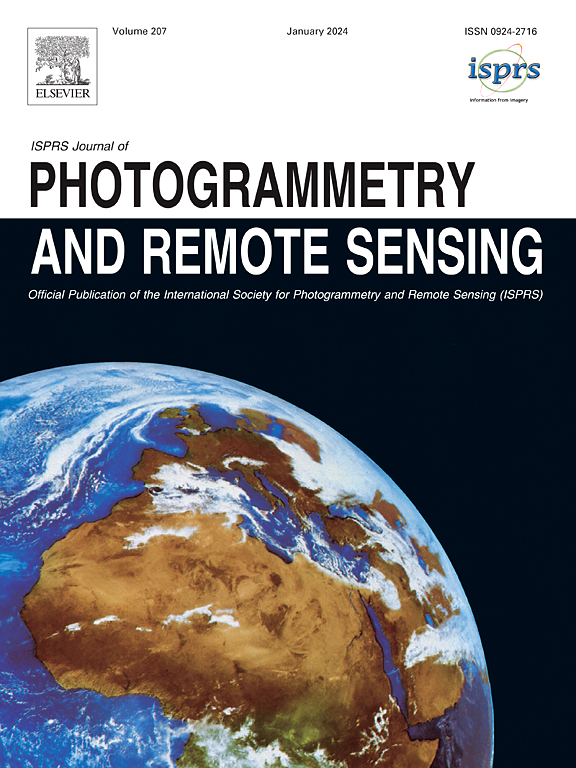Twin deformable point convolutions for airborne laser scanning point cloud classification
IF 10.6
1区 地球科学
Q1 GEOGRAPHY, PHYSICAL
ISPRS Journal of Photogrammetry and Remote Sensing
Pub Date : 2025-02-07
DOI:10.1016/j.isprsjprs.2025.01.031
引用次数: 0
Abstract
Thanks to the application of deep learning technology in point cloud processing of the remote sensing field, point cloud classification has become a research hotspot in recent years. Although existing solutions have made unprecedented progress, they ignore the inherent characteristics of point clouds in remote sensing fields that are strictly arranged according to latitude, longitude, and altitude, which brings great convenience to the segmentation of point clouds in remote sensing fields. To consider this property cleverly, we propose novel convolution operators, termed Twin Deformable point Convolutions (TDConvs), which aim to achieve adaptive feature learning by learning deformable sampling points in the latitude–longitude plane and altitude direction, respectively. First, to model the characteristics of the latitude–longitude plane, we propose a Cylinder-wise Deformable point Convolution (CyDConv) operator, which generates a two-dimensional cylinder map by constructing a cylinder-like grid in the latitude–longitude direction, and then performs adaptive feature sampling on the cylinder map by deformable offset learning. Furthermore, to better integrate the features of the latitude–longitude plane and the spatial geometric features, we perform a multi-scale fusion of the extracted latitude–longitude features and spatial geometric features, and realize it through the aggregation of adjacent point features of different scales. In addition, a Sphere-wise Deformable point Convolution (SpDConv) operator is introduced to adaptively offset the sampling points in three-dimensional space by constructing a sphere grid structure, aiming at modeling the characteristics in the altitude direction. Experiments on existing popular benchmarks conclude that our TDConvs achieve the best segmentation performance, surpassing existing advanced methods such as RFFS-Net and MCFN. Specifically, TDConvs achieves 73.4% mF1 on the ISPRS Vaihingen 3D dataset, which is 4.8% higher than the baseline. Details of the datasets used and the code is available on https://github.com/WingkeungM/TDConvs.
基于双变形点卷积的机载激光扫描点云分类
由于深度学习技术在遥感领域点云处理中的应用,点云分类成为近年来的研究热点。现有的解决方案虽然取得了前所未有的进步,但忽略了遥感领域点云按照经纬度、高度严格排列的固有特征,这给遥感领域点云的分割带来了极大的便利。为了巧妙地考虑这一特性,我们提出了新的卷积算子,称为双变形点卷积(TDConvs),其目的是通过分别学习经纬度平面和高度方向上的可变形采样点来实现自适应特征学习。首先,为了对经纬度平面的特征进行建模,我们提出了一种圆柱形可变形点卷积算子(CyDConv),该算子通过在经纬度方向上构造一个类圆柱形网格来生成二维圆柱形图,然后通过可变形偏移学习对圆柱形图进行自适应特征采样。此外,为了更好地整合经纬度平面特征和空间几何特征,我们将提取的经纬度特征和空间几何特征进行多尺度融合,并通过聚集不同尺度的相邻点特征来实现。此外,引入SpDConv算子,通过构造球面网格结构,自适应偏移采样点在三维空间中的位置,以模拟海拔方向上的特征。在现有的流行基准测试上的实验表明,我们的TDConvs实现了最佳的分割性能,超过了现有的先进方法,如RFFS-Net和MCFN。具体来说,TDConvs在ISPRS Vaihingen 3D数据集上实现了73.4% mF1,比基线高4.8%。使用的数据集和代码的详细信息可在https://github.com/WingkeungM/TDConvs上获得。
本文章由计算机程序翻译,如有差异,请以英文原文为准。
求助全文
约1分钟内获得全文
求助全文
来源期刊

ISPRS Journal of Photogrammetry and Remote Sensing
工程技术-成像科学与照相技术
CiteScore
21.00
自引率
6.30%
发文量
273
审稿时长
40 days
期刊介绍:
The ISPRS Journal of Photogrammetry and Remote Sensing (P&RS) serves as the official journal of the International Society for Photogrammetry and Remote Sensing (ISPRS). It acts as a platform for scientists and professionals worldwide who are involved in various disciplines that utilize photogrammetry, remote sensing, spatial information systems, computer vision, and related fields. The journal aims to facilitate communication and dissemination of advancements in these disciplines, while also acting as a comprehensive source of reference and archive.
P&RS endeavors to publish high-quality, peer-reviewed research papers that are preferably original and have not been published before. These papers can cover scientific/research, technological development, or application/practical aspects. Additionally, the journal welcomes papers that are based on presentations from ISPRS meetings, as long as they are considered significant contributions to the aforementioned fields.
In particular, P&RS encourages the submission of papers that are of broad scientific interest, showcase innovative applications (especially in emerging fields), have an interdisciplinary focus, discuss topics that have received limited attention in P&RS or related journals, or explore new directions in scientific or professional realms. It is preferred that theoretical papers include practical applications, while papers focusing on systems and applications should include a theoretical background.
 求助内容:
求助内容: 应助结果提醒方式:
应助结果提醒方式:


